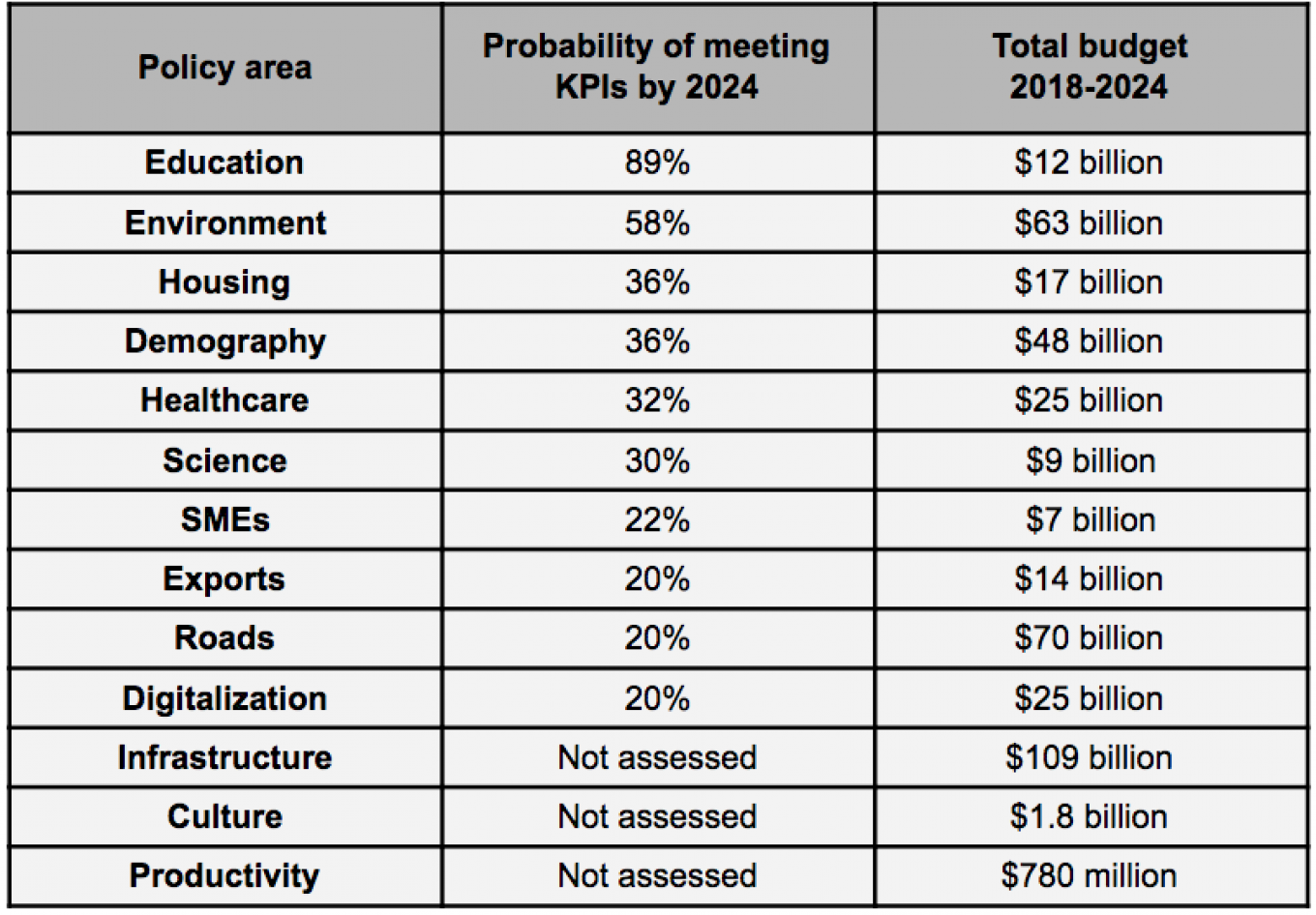President Vladimir Putin is unlikely to meet most of his flagship economic and development goals during his final term without a significant increase in spending and better performance on a host of key indicators, a new report from a government-owned bank said Wednesday.
The National Projects program — a $400 billion package of investments covering everything from new roads and railways to healthcare, demographics, digitalization and import substitution — is the backbone of Putin’s fourth term as president.
The ambitious plan touches almost every part of the Russian economy and is nothing short of a mammoth agenda for Russia’s economic transformation designed to kick-start a long-awaited increase in living standards. Almost half of the budget for the National Projects — 11.5 trillion rubles ($180 billion) — is set to be spent on developing Russia’s infrastructure, including its road network.
However, echoing concerns flagged by most analysts, findings by economists at state-owned VTB Bank show that the program may well be too ambitious, and a number of its targets are not on track to be met before Putin is scheduled to step down in 2024.
The analysis, covering 10 of the 13 packages of policies that make up the National Projects, showed that eight have a less than 50% chance of meeting their own targets on current trends. For the three worst — digitization of the Russian economy, road-building and boosting exports — the likelihood of success stands at just 20%.
Targets for improving education and the environment were deemed the most likely to succeed, with an 89% and 58% chance.
VTB called the program “highly ambitious”, but “achievable” adding: “In order to improve the probability of achieving most of its targets, the government might need to increase the volume of allocated resources,” from its current level of 25.6 trillion rubles ($400 billion) said Alexander Isakov, the VTB analyst who put together the new study.

VTB forecast the probability of success by looking at recent trends for the 118 individual targets and key performance indicators for the National Projects. The probabilities are an extrapolation of recent trends and do not account for future “policy intervention” which could increase the chances of success, the report’s authors said. VTB notes that “most of the paths the government sets for achieving targets are close to the linear trend, thus our probability might be close to the government’s own.”
Targets include reducing infant mortality, higher spending on research and development, better productivity rates, and increasing the quality of Russia’s housing stock.
VTB disregarded the 70% of indicators which were not quantifiable or had goals where they could not find previous data to make their calculations.
Ruben Enikolopov, rector of Moscow’s New Economic School told The Moscow Times this dominance of non-quantifiable targets was in fact one of the main problems with the National Projects, as it leaves open the possibility for “different interpretations” or “manipulation” in the future, should it look like the government will fall short.
The program has also been slow to get off the ground, and a number of the policies needed to provide funding for its initiatives — an increase in Russia’s pension age and a hike in VAT — have proved controversial.
Government figures released recently showed that in the first nine months of 2019 only 52% of the funds allocated for the year had been spent. Another independent study found that the benefits of economic growth this year are likely to be wiped out by the costs of Putin’s VAT increase.
“The system of public administration is in a general state where it cannot digest the allocated funds,” Enikolopov said. “Ultimately, it is the quality of public administration and not the amount of money that determines the success of any public project.”
VTB’s analysis showed the likelihood of an individual project’s success is not related to the government’s slow spending. Projects which had already fallen behind schedule were no more likely to fail than those that were on track.
Instead, looking at where the government has spent its money is a “good proxy” for judging which parts of the National Projects are being prioritized, the bank said. It highlighted healthcare, science and demography as the three areas with the highest spending as a proportion of their budget, while the environment and digitalization were those most lagging.
“There is no major surprise here. The National Projects are not going to hit their key performance indicators,” said Sofya Donets, an economist at Renaissance Capital.
“To start with, the president’s May Decrees set the target that Russia should consistently grow above the world average — close to 3.5% a year. Did the markets, or government itself, truly believe that this is achievable? The honest answer — definitely not.”
Donets added that the effectiveness of the program should be measured by the pick-up in government spending and the effects this could have on wider economic growth. She estimated that spending on the National Projects, combined with a general loosening of the government’s tight fiscal policy could boost annual GDP growth by a full percentage point.
Russia’s economy is currently set to grow by around 1% this year, with economists estimating Russia’s annual growth will step-up to around 1.5-2% over the next few years — far short of Putin’s 3.5% goal.
The New Economic School’s Enikolopov added: “The goals set by the National Projects are extremely ambitious. There is very little optimism that the goals will be reached and even less optimism that it will happen in the declared time.”

Leave a Reply